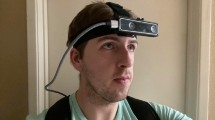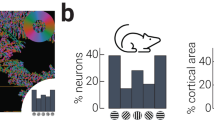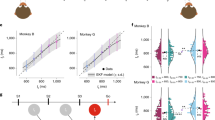Abstract
Because sensory systems often provide ambiguous information, neural processes must exist to resolve these ambiguities. It is likely that similar neural processes are used by different sensory systems. For example, many tasks require neural processing to distinguish linear acceleration from gravity1, but Einstein's equivalence principle states that all linear accelerometers must measure both linear acceleration and gravity. Here we investigate whether the brain uses internal models, defined as neural systems that mimic physical principles, to help estimate linear acceleration and gravity2,3,4. Internal models may be used in motor control5,6,7, sensorimotor integration8,9,10 and sensory processing11,12,13,14, but direct experimental evidence for such models is limited. To determine how humans process ambiguous gravity and linear acceleration cues, subjects were tilted after being rotated at a constant velocity about an Earth-vertical axis. We show that the eye movements evoked by this post-rotational tilt include a response component that compensates for the estimated linear acceleration even when no actual linear acceleration occurs. These measured responses are consistent with our internal model predictions that the nervous system can develop a non-zero estimate of linear acceleration even when no true linear acceleration is present.
This is a preview of subscription content, access via your institution
Access options
Subscribe to this journal
Receive 51 print issues and online access
$199.00 per year
only $3.90 per issue
Buy this article
- Purchase on Springer Link
- Instant access to full article PDF
Prices may be subject to local taxes which are calculated during checkout




Similar content being viewed by others
References
Young, L. in Handbook of Physiology—The Nervous System(ed. Darian-Smith, I.) 1023–1066 (American Physiological Society, Bethesda, Maryland, 1984).
Ormsby, C. & Young, L. Integration of semicircular canal and otolith information for multisensory orientation stimuli. Math. Biosci. 34, 1–21 (1977).
Merfeld, D. M. & Young, L. R. The vestibulo-ocular reflex of the squirrel monkey during eccentric rotation and roll tilt. Exp. Brain Res. 106, 111–122 (1995).
Merfeld, D. M. Modeling the vestibulo-ocular reflex of the squirrel monkey during eccentric rotation and roll tilt. Exp. Brain Res. 106, 123–134 (1995).
Yasui, S. & Young, L. Perceived visual motion as effective stimulus to pursuit eye movement system. Science 190, 906–908 (1975).
Darlot, C., Zupan, L., Etard, O., Denise, P. & Maruani, A. Computation of inverse dynamics for the control of movements. Biol. Cybern. 75, 173–186 (1996).
Wolpert, D., Ghahramani, Z. & Jordan, M. An internal model for sensorimotor integration. Science 269, 1880–1882 (1995).
Paulin, M. G. The role of the cerebellum in motor control and perception. Brain Behav. Evol. 41, 39–50 (1993).
Bell, C., Bodznick, D., Montgomery, J. & Bastian, J. The generation and subtraction of sensory expectations within cerebellum-like structures. Brain Behav. Evol. 50 (suppl. 1),17–31 (1997).
Kuo, A. An optimal control model for analyzing human postural balance. IEEE Trans. Biomed. Eng. 42, 87–101 (1995).
Droulez, J. & Darlot, C. in Attention and Performance XIII(ed. Jeannerod, M.) 495–526 (Erlbaum, New York, 1989).
Glasauer, S. Interaction of semicircular canals and otoliths in the processing structure of the subjective zenith. Annl. N. Y. Acad. Sci. 656, 847–849 (1992).
Rao, R. & Ballard, D. Dynamic model of visual recognition predicts neural response properties in the visual cortex. Neural Comput. 9, 721–763 (1997).
Lewald, J. & Ehrenstein, W. Influence of head-to-trunk position on sound lateralization. Exp. Brain Res. 121, 230–238 (1998).
Schwarz, C., Busettini, C. & Miles, F. Ocular responses to linear motion are inversely proportional to viewing distance. Science 245, 1394–1396 (1989).
Paige, G. & Tomko, D. Eye movement responses to linear head motion in the squirrel monkey. I. Basic characteristics. J. Neurophysiol. 65, 1170–1182 (1991).
Schwarz, C. & Miles, F. Ocular responses to translation and their dependence on viewing distance. I. Motion of the observer. J. Neurophysiol. 66, 851–864 (1991).
Wilson, V. & Melvill Jones, G. Mammalian Vestibular Physiology(Plenum, New York, 1979).
Guedry, F. in Handbook of Sensory Physiology(ed. Kornhuber) 1–154 (Springer, New York, 1974).
Stockwell, C. & Guedry, F. The effect of semicircular canal stimulation during tilting on the subsequent perception of the visual vertical. Acta Otolaryngol. 70, 170–175 (1970).
Dichgans, J., Held, R., Young, L. R. & Brandt, T. Moving visual scenes influence the apparent direction of gravity. Science 178, 1217–1219 (1972).
Benson, A. & Bodin, M. Comparison of the effect of the direction of the gravitational acceleration on post-rotational responses in yaw, pitch, and roll. Aerospace Med. 37, 889–897 (1966).
Goldberg, J. & Fernandez, C. Physiology of peripheral neurons innervating semicircular canals of the squirrel monkey. I. Resting discharge and response to constant angular accelerations. J. Neurophysiol. 34, 635–660 (1971).
Benson, A. in Handbook of Sensory Physiology Vol. VI, Vestibular System Part 2: Psychophysics, Applied Aspects and General Interpretations.(ed. Kornhuber, H.) 281–320 (Springer, Berlin, Heidelberg and New York, 1974).
Fetter, M., Tweed, D., Hermann, W., Wohland-Braun, B. & Koenig, E. The influence of head position and head reorientation on the axis of eye rotation and the vestibular time constant during postrotatory nystagmus. Exp. Brain Res. 91, 121–128 (1992).
Merfeld, D. M. Modeling human vestibular responses during eccentric rotation and off vertical axis rotation. Acta Otolaryngol. (suppl. 520),354–359 (1995).
Merfeld, D. M., Young, L., Oman, C. & Shelhamer, M. Amulti-dimensional model of the effect of gravity on the spatial orientation of the monkey. J. Vestibular Res. 3, 141–161 (1993).
Angelaki, D., McHenry, M., Dickman, J. D., Newlands, S. & Hess, B. Computation of inertial motion: Neural strategies to resolve ambiguous otolith information. J. Neurosci. 19, 316–327 (1999).
Acknowledgements
We thank S. Clark-Donovan and J. Roth for assistance throughout and T. Inglis, G.McCollum, S. Oster, P. Roberts, C. Wall and the NSI sensorimotor journal club for comments on the manuscript. This work was supported by grants from the NIH/NIDCD (D.M.M.), ESA (L.Z.), and NIH/NASA (R.J.P.).
Author information
Authors and Affiliations
Corresponding author
Rights and permissions
About this article
Cite this article
Merfeld, D., Zupan, L. & Peterka, R. Humans use internal models to estimate gravity and linear acceleration. Nature 398, 615–618 (1999). https://doi.org/10.1038/19303
Received:
Accepted:
Issue Date:
DOI: https://doi.org/10.1038/19303
This article is cited by
-
Disturbance Rejection in the Cerebellum
SN Computer Science (2024)
-
Vestibular contributions to linear motion perception
Experimental Brain Research (2024)
-
Microgravity induces overconfidence in perceptual decision-making
Scientific Reports (2023)
-
Postural adaptation to microgravity underlies fine motor impairment in astronauts’ speech
Scientific Reports (2023)
-
Preventing falls: the use of machine learning for the prediction of future falls in individuals without history of fall
Journal of Neurology (2023)
Comments
By submitting a comment you agree to abide by our Terms and Community Guidelines. If you find something abusive or that does not comply with our terms or guidelines please flag it as inappropriate.



